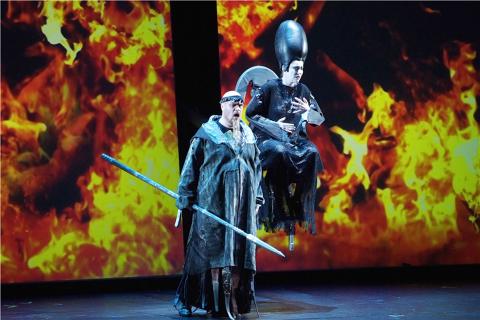The National Theater Taichung (NTT) opened its “The Fall for Great Souls” series last night with the first of three performances of Barcelona-based La Fura dels Baus’ terrific, sci-fi centric production of Richard Wagner’s Siegfried, backed by the National Symphony Orchestra (NSO, 國家交響樂團) under conductor Lu Shao-chia (呂紹嘉).
Siegfried is the first of 10 programs that include Austrian-based Taiwanese choreographer Lin Mei-hong’s (林美虹) The Little Mermaid for the Landestheater Linz Ballet, where she is artistic director, on Nov. 3 and Nov. 4, Etat de siege by the Theatre de la Ville, Cloud Gate Dance Theatre’s (雲門舞集) 45th anniversary show and Hsu Yafen Taiwanese Opera Troupe’s (許亞芬歌子戲劇坊) production of The Soul Switch and Justice Bao (謎魂奇案).
Siegfried, the third of the four operas that constitute Wagner’s The Ring of the Nibelung is a brave choice to start the series, given that the three-act production lasts for five hours, with two intermissions.

Photo courtesy of Tato Baeza
The 39-year-old La Fura dels Baus and Carlus Padrissa, one of the troupe’s six directors, are renowned for their futuristic 3D stage designs and blurring the boundaries between actors and audience, and this production of Siegfried is no exception.
Padrissa’s multimedia vision of the opera, which premiered in 2008 in the Palau de les Arts in Valencia, Spain, with Zubin Mehta conducting, features video projections in three dimensions, an 11m dragon, acrobats, glass floors that reflect the duality of the character.
The sets were designed by Roland Olbeter, the costumes by Chu Uroz and the lighting by Peter Van Praet.

Photo courtesy of Tato Baeza
Padrissa sees Siegfried, a man who does not know who he is or who is parents were, as a man in a permanent state of combustion in his pursuit of the idea of justice for all.
A super-condensed summary of the opera goes like this: a dwarf, Mime, raises a boy, Siegfried, as his own, hoping that he will be able to one day slay the dragon Fafner, which stole a huge treasure from Mime’s brother, Alberich, including a ring that gives is wearer power over the entire planet.
After Siegfried grows up, with the help of a mysterious wanderer (actually the god Wotan), he is finally able to reforge his father’s sword, which he uses to kill the dragon. He also eventually kills Mime, claims the ring of power and rescues a beautiful woman, Brunnhilde, who is meant to be his wife.

Photo courtesy of Tato Baeza
It is a story of treachery, the pursuit of justice and the desire for love: lots of drama, lots of high notes.
The cast includes Vincent Wolfsteiner as Siegfried, Rodell Rosel as Mime, Jukka Rasilainen as The Wanderer and Susan Bullock as Brunnhilde.
The opera will be sung in German, with English and Chinese surtitles.
If the high prices of the tickets are not enough to scare away Wagner or La Fura dels Baus fans, the idea of a marathon performance that starts before most people have had their dinners (5pm) might be, so the NTT is offering a meal service during the intermissions, with advance reservations via its Web site or the NTCH ticketing system.

Most heroes are remembered for the battles they fought. Taiwan’s Black Bat Squadron is remembered for flying into Chinese airspace 838 times between 1953 and 1967, and for the 148 men whose sacrifice bought the intelligence that kept Taiwan secure. Two-thirds of the squadron died carrying out missions most people wouldn’t learn about for another 40 years. The squadron lost 15 aircraft and 148 crew members over those 14 years, making it the deadliest unit in Taiwan’s military history by casualty rate. They flew at night, often at low altitudes, straight into some of the most heavily defended airspace in Asia.

Beijing’s ironic, abusive tantrums aimed at Japan since Japanese Prime Minister Sanae Takaichi publicly stated that a Taiwan contingency would be an existential crisis for Japan, have revealed for all the world to see that the People’s Republic of China (PRC) lusts after Okinawa. We all owe Takaichi a debt of thanks for getting the PRC to make that public. The PRC and its netizens, taking their cue from the Chinese Communist Party (CCP), are presenting Okinawa by mirroring the claims about Taiwan. Official PRC propaganda organs began to wax lyrical about Okinawa’s “unsettled status” beginning last month. A Global

Taiwan’s democracy is at risk. Be very alarmed. This is not a drill. The current constitutional crisis progressed slowly, then suddenly. Political tensions, partisan hostility and emotions are all running high right when cool heads and calm negotiation are most needed. Oxford defines brinkmanship as: “The art or practice of pursuing a dangerous policy to the limits of safety before stopping, especially in politics.” It says the term comes from a quote from a 1956 Cold War interview with then-American Secretary of State John Foster Dulles, when he said: ‘The ability to get to the verge without getting into the war is

Like much in the world today, theater has experienced major disruptions over the six years since COVID-19. The pandemic, the war in Ukraine and social media have created a new normal of geopolitical and information uncertainty, and the performing arts are not immune to these effects. “Ten years ago people wanted to come to the theater to engage with important issues, but now the Internet allows them to engage with those issues powerfully and immediately,” said Faith Tan, programming director of the Esplanade in Singapore, speaking last week in Japan. “One reaction to unpredictability has been a renewed emphasis on